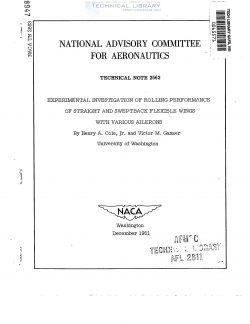naca-tn-2563
- Version
- 111 Downloads
- 1.26 MB File Size
- 1 File Count
- December 16, 2016 Create Date
- December 16, 2016 Last Updated
National Advisory Committee for Aeronautics, Technical Notes - Experimental Investigation of Rolling Performance of Straight and Sweptback Flexible Wings with Various Ailerons

Two flexible wings, one with #50 sweepback and the other unswept,
were tested by the University of Washington Aeronautical Laboratories
to determine their performance~in roll. Rolling moments due to aileron
deflection, damping derivatives in roll, and free-rolling angular V6106-
ities due to aileron deflection were obtained at various speeds including,
when possible, the aileron reversal speed.
During the test a secondary flow, which made testing in free roll
virtually impossible, was discovered in the test section of the wind
tunnel. The condition of free roll was then simulated by driving the
model at constant velocity at zero average rolling moment.‘
The results showed that, when designed for equal stress, the swept
wing had generally higher reversal speeds than did the straight wing.
Also, it was shown that inboard ailerons for the swept wing were more
effective at high speeds than were ailerons extending to the tips.
The experimental values were used to check theory, with good agree-
ment in the case of the straight wing but with unsatisfactory agreement
in the case of the swept wing where the theory overestimated reversal
speed for all ailerons larger than the 0.2-span ailerons.
The loss in rolling performance at high speeds due to the elasticity
of the wing structure of an airplane has been of concern for many years.
Until a few years ago airplane wings had little or no sweepback, and the
torsional deflection alone was responsible for this loss in rolling per-
formance. This effect usually is identified with the "aileron reversal
speed" - the speed at which the ailerons become completely ineffective
in rolling the airplane. In recent years large amounts of sweepback
have been incorporated in various airplanes in an attempt to increase
critical Mach numbers of the wings. The inclusion of sweepback has made
the prediction of rolling performance even more difficult, since the
bending deflections of swept wings change the angle—of-attack distribution
along the wings. This change, in turn, affects the rolling moments
developed as well as the torsional moments about the elastic axis.
The inclusion of bending and the greater difficulty in calculating spanwise
loadings for swept wings make the theoretical approach difficult and
also make the need for experimental data for checking greater.
The experimental data presented in this report consist of the results
of tests of two elastic wings, one with sweepback and one unswept. The
wings were tested in a fixed position with ailerons deflected, were
allowed to roll at equilibrium rolling velocity, and were driven in roll
to get damping coefficients.
| File | Action |
|---|---|
| naca-tn-2563 Experimental Investigation of Rolling Performance of Straight and Sweptback Flexible Wings with Various Ailerons.pdf | Download |
Comment On This Post